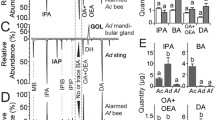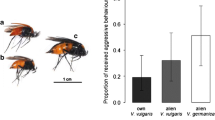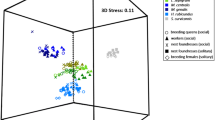Abstract
Most social bees collect floral resources to obtain proteins and carbohydrates. However, the obligate cleptoparasite stingless bee Lestrimelitta limao, the so-called robber bee, is a rare exception as it collects resources by raiding other stingless bee nests. The mechanisms these bees use to overcome host colony defenses are poorly understood. Many host species retreat inside the nest during L. limao attacks and the signals triggering this behavior require a better understanding. While some researchers have proposed that robber bees release chemical compounds that are responsible for host retreat, others have hypothesized that the observed behavior results from communication among host workers. In order to investigate the role of interspecific signals in raids, we tested the effects of robber bees’ mandibular and labial gland secretions on the behavior of Frieseomelitta varia workers. We combined behavioral assays with chemical and electrophysiological analyses. We found that citral and 9-nonacosene are major mandibular gland compounds and two esters, hexadecyl acetate and 9-hexadecenyl acetate, are major labial gland compounds. These three major compounds elicited electro-physiological responses on host worker antennae. Robber bee labial gland extracts repelled both foragers and guards, while mandibular gland content increased aggression. Our results suggest that interspecific communication plays a role during natural raids and that esters from L. limao labial glands, rather than citral, are more likely to trigger the host retreat. The results add to our knowledge about L. limao chemical communication and help to elucidate the mechanisms involved in their intriguing foraging strategy.




Similar content being viewed by others
References
Blum MS, Crewe RM, Kerr WE, Keith LH, Garrison W, Walker MM (1970) Citral in stingless bees: isolation and functions in trail-laying and robbing. J Insect Physiol 16:1637–1648
Core Team R (2013) R: A Language and Environment for Statistical Computing. R Foundation for Statistical Computing, Vienna
D’Ettorre P, Errard C, Ibarra F, Francke W, Hefetz A (2000) Sneak in or repel your enemy: Dufour’s gland repellent as a strategy for successful usurpation in the slave-maker Polyergus rufescens. Chemoecology 10:135–142
Francke W, Lübke G, Schröder W, Reckziegel A, Imperatriz-Fonseca V, Kleinert A, Engels E, Hartfelder K, Radtke R, Engels W (2000) Identification of oxygen containing volatiles in cephalic secretions of workers of Brazilian stingless bees. J Braz Chem Soc 11:562–571
Grimaldi D, Engel MS (2005) Evolution of the Insects. Cambridge University Press, Cambridge
Jarau S (2009) Chemical communication during food exploitation in stingless bees. In: Jarau S, Hrncir M (eds) Food exploitation by social insects: ecological, behavioral and theoretical approaches. CRC Press, Boca Raton FL, pp 223–249
Jarau S, Hrncir M, Zucchi R, Barth FG (2004) A stingless bee uses labial gland secretions for scent trail communication (Trigona recursa Smith 1863). J Comp Physiol A 190:233–239
Jarau S, Schulz CM, Hrncir M, Francke W, Zucchi R, Barth FG, Ayasse M (2006) Hexyl decanoate the first trail pheromone compound identified in a stingless bee Trigona recursa. J Chem Ecol 32:1555–1564
Jarau S, Dambacher J, Twele R, Aguilar I, Francke W, Ayasse M (2010) The trail pheromone of a stingless bee Trigona corvina (Hymenoptera Apidae Meliponini) varies between populations. Chem Senses 35:593–601
Kerr WE (1951) Bases para o estudo da genética de populações dos Hymenoptera em geral e dos Apinae sociais em particular. Anais da Escola Superior de Agricultura Luiz de Queiroz 8:219–354
Lichtenberg E, Hrncir M, Turatti I, Nieh J (2010) Olfactory eavesdropping between two competing stingless bee species. Behav Ecol Sociobiol 65:763–774
Lichtenberg E, Zivin J, Hrncir M, Nieh J (2014) Eavesdropping selects for conspicuous signals. Curr Biol 24:R598–R599
Michener CD (1946) Notes on the Habits of Some Panamanian Stingless Bees (Hymenoptera: Apidae). J New York Entomol Soc 54:179–197
Morgan ED (1990) Preparation of small scale samples from insects for cromatography. Anal Chim Acta 236:227–235
Moure JS, Nogueira-Neto P, Kerr WE (1958) Evolutionary problems among Meliponinae (Hymenoptera Apidae). Proceed 10th Int Cong Entomol 2:481–493
Nogueira-Neto P (1970) Behavior problems related to the pillages made by some parasitic stingless bees (Meliponinae, Apidae). In: Aronson LR (ed) Development and evolution of behavior: Essays in memory of TC Schneirla. W. H. Freeman San Francisco, California, pp 416–434
Nordlund DA, Lewis WJ (1976) Terminology of chemical releasing stimuli in intraspecific and interspecific interactions. J Chem Ecol 2:211–220
Nunes T (2012) Sobre a ecologia química de Friesella schrottkyi Friese 1900 (Hymenoptera: Apidae: Meliponini) com ênfase na regulação social (On the chemical ecology of Friesella schrottkyi). Doctoral thesis, Universidade de São Paulo
Nunes TM, von Zuben LG, Costa L, Venturieri GC (2014) Defensive repertoire of the stingless bee Melipona flavolineata Friese (Hymenoptera: Apidae). Sociobiology 61:541–546
Pompeu MS, Silveira FA (2005) Reaction of Melipona rufiventris lepeletier to citral and against an attack by the cleptobiotic bee Lestrimelitta limao. Brazil J Biol 65:189–191
Regnier FE, Wilson EO (1971) Chemical communication and “propaganda” in slave-maker ants. Science 172:267–269
Roubik DW (1989) Ecology and Natural History of Tropical Bees. Cambridge University Press, Cambridge
Sakagami SF, Laroca S (1963) Additional observations on the habits of the cleptobiotic stingless bees the genus Lestrimelitta Friese (Hymenoptera, Apoidea). J Faculty Sci Hokkaido Univ Serv 15:15319–15339
Sakagami SF, Roubik DW, Zucchi R (1993) Ethology of the robber stingless bee Lestrimelitta limao (Hymenoptera Apidae). Sociobiology 21:237–277
Schorkopf DLP, Jarau S, Francke W, Twele R, Zucchi R, Hrncir M, Schmidt VM, Ayasse M, Barth FG (2007) Spitting out information: Trigona bees deposit saliva to signal resource locations. Proc Roy Soc London B: Biol Sci 274:895–899
Schorkopf DLP, Hrncir M, Mateus S, Zucchi R, Schmidt VM, Barth FG (2009) Mandibular gland secretions of meliponine worker bees: further evidence for their role in interspecific and intraspecific defence and aggression and against their role in food source signalling. J Exper Biol 212:1153–1162
Stangler ES, Jarau S, Hrncir M, Zucchi R, Ayasse M (2009) Identification of trail pheromone compounds from the labial glands of the stingless bee Geotrigona mombuca. Chemoecology 19:13–19
Tsuneoka Y, Akino T (2009) Repellent effect on host Formica workers of queen Dufour’s gland secretion of the obligatory social parasite ant Polyergus samurai (Hymenoptera: Formicidae). Appl Entomol Zool 44:133–141
van Zweden JS, Grüter C, Jones SM, Ratnieks FLW (2011) Hovering guards of the stingless bee Tetragonisca angustula increase colony defensive perimeter as shown by intra- and inter-specific comparisons. Behav Ecol Sociobiol 65:1277–1282
Wittmann D (1985) Aerial Defense of the Nest by Workers of the Stingless Bee Trigona (Tetragonisca) angustula (Latreille) (Hymenoptera: Apidae). Behav Ecol Sociobiol 16:111–114
Wittmann D, Radtke R, Zeil J, Lübke G, Francke W (1990) Robber bees (Lestrimelitta limao) and their host chemical and visual cues in nest defense by Trigona (Tetragonisca) angustula (Apidae: Meliponinae). J Chem Ecol 16:631–641
Zar JH (2010) Biostatistical Analysis. Prentice Hall, New Jersey
Zimma BO, Ayasse M, Tengö J, Ibarra F, Schulz C, Francke W (2003) Do social parasitic bumblebees use chemical weapons? (Hymenoptera Apidae). J Comp Physiol A 189:769–775
Acknowledgments
We are thankful to Prof. Ronaldo Zucchi for all his support and encouragement. Prof. Fábio Santos do Nascimento for kindly allowing the access to a GC–MS equipment during the bio-essays. Prof. David Morgan for the help with the identification of the chemical compounds. Christoph Grueter and Prof. Wittko Francke for valuable comments and suggestions in earlier versions of this manuscript. Sidnei Mateus and Izabel Cristina Turatti for their immeasurable technical support. This research was supported by Fundação de Amparo à Pesquisa do Estado de São Paulo (FAPESP 2010/04704-4; Proc. 2010/10027-5, 2011/22991-3, 2013/04766-8 and 2013/01918-1).
Author information
Authors and Affiliations
Corresponding author
Electronic supplementary material
Below is the link to the electronic supplementary material.
Rights and permissions
About this article
Cite this article
von Zuben, L.G., Schorkopf, D.L.P., Elias, L.G. et al. Interspecific chemical communication in raids of the robber bee Lestrimelitta limao . Insect. Soc. 63, 339–347 (2016). https://doi.org/10.1007/s00040-016-0474-2
Received:
Revised:
Accepted:
Published:
Issue Date:
DOI: https://doi.org/10.1007/s00040-016-0474-2




